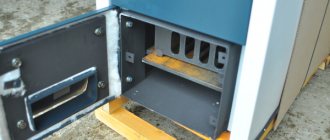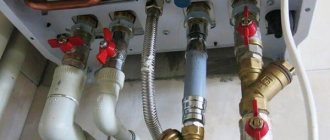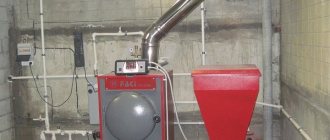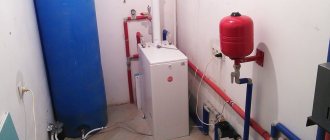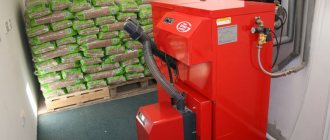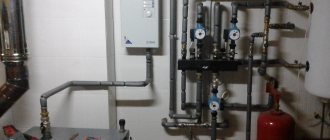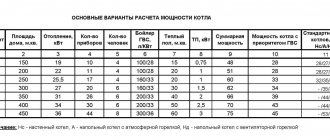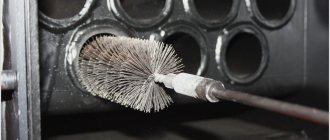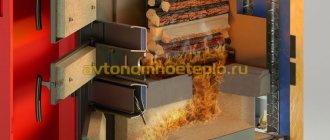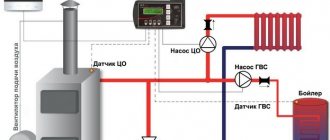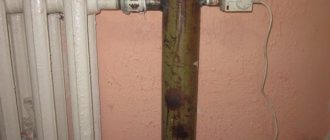Design features and operating principle
Long-burning top-loading boiler - diagram
The internal part is used as a firebox. It is designed so that combustion occurs from top to bottom. This is helped by a special air supply directly to the combustion zone. The process is more reminiscent of smoldering with the production of gases from carbon-containing fuel. To a large extent, these gases are flammable. Due to their combustion in the upper part of the firebox, maximum use of thermal energy occurs, which allows increasing heat transfer and reducing fuel consumption.
The boiler chamber is divided into two parts by an air distributor. It has the shape of a pipe, to which a platform with blades is attached at one end, and the other end serves to supply oxygen.
Boilers with top combustion are characterized by cyclical operation, and until the first fill burns out, adding a second batch of fuel will not be necessary.
How to make a long-burning solid fuel boiler with your own hands: drawings and design diagrams
Before you start making a boiler, you need to decide on its design. Its choice depends on the purpose of the unit. If it is intended for heating a small utility room, garage or country house, then it is not necessary to install a water circuit in it. Heating of such a room will occur directly from the surface of the boiler, through convection of air masses in the room, like from a furnace. For greater efficiency, you can arrange for forced airflow of the unit using a fan. If there is a liquid heating system in the room, it is necessary to provide a circuit device in the boiler in the form of a pipe coil or other similar structure.
Solid fuel boiler: photo, features, device, wiring diagram: (read more)
Connection diagram of a solid fuel boiler to the heating system.
The choice of option also depends on the type of solid fuel that will need to be used. For heating with ordinary wood, an increased volume of the firebox is required, and for the use of small fuel pellets, you can arrange a special container from which the granulated fuel is supplied to the boiler automatically. To make a long-burning solid fuel boiler with your own hands, you can take a universal drawing. It is suitable for any type of solid fuel used. Diagram of connecting a solid fuel boiler to the heating system
Drawing of a long-burning solid fuel boiler with a power of 25/30/40 kW.
We will tell you step by step how and from what parts you can make a long-burning solid fuel heating boiler according to the proposed scheme:
- We will prepare the place where the future unit will be installed. The base on which it will stand must be level, strong, rigid and fire-resistant. A concrete foundation or a thick cast iron or steel slab is best suited for this. The walls also need to be covered with fire-resistant material if they are wooden;
- We collect all the necessary material and tools: of which we need an electric arc welding machine, a grinder and a tape measure. Made of materials: 4 mm sheet steel; 300 - mm steel pipe with 3 mm walls, as well as other pipes of 60 and 100 mm in diameter;
The structure and principle of operation of a solid fuel boiler.
- in order to make a long-burning solid fuel boiler, you need to cut a piece 1 m long from a large 300 mm pipe. You can do it a little less, if necessary;
- We cut out the bottom from a steel sheet according to the diameter of the pipe and weld it, equipping it with channel legs up to 10 cm long;
- The air distributor is made in the form of a circle made of a sheet of steel with a diameter 20 mm smaller than the pipe. An impeller from a corner with a flange size of 50 mm is welded into the lower part of the circle. For this, you can use a channel of a similar size;
- We weld a 60 mm pipe into the middle of the distributor from above, which should be higher than the boiler. In the middle of the distributor disk we cut a hole along the pipe so that there is a through tunnel. It is needed for air supply. A damper is embedded in the upper part of the pipe, which will allow you to adjust the air supply;
Schematic representation of the structure of a boiler operating on solid fuel.
- in the very bottom part of the boiler we make a small door, equipped with a valve and hinges, leading to the ash pan for easy removal of ash. We cut a hole in the top of the boiler for the chimney and weld a 100 mm pipe into this place. At first it goes at a slight angle to the side and up 40 cm, and then strictly vertically up. The passage of the chimney through the ceiling of the room must be protected according to fire safety rules;
- We complete the construction of a long-burning solid fuel heating boiler by manufacturing the top cover. There should be a hole in its center for the air flow distributor pipe. The fit to the walls of the boiler must be very tight, preventing air from entering.
Drawing with dimensions for creating a solid fuel boiler with your own hands.
On a note! To ignite a self-made, long-burning solid fuel boiler, the drawing of which was presented above, you need to: remove the lid and lift the regulator, fill the boiler with fuel to the top and pour flammable liquid over it, put everything in place and throw a burning splinter into the regulator pipe. When the fuel flares up, reduce the air flow to a minimum so that it only begins to smolder. After this, the pyrolysis gas will ignite and the boiler will start.
Long-burning boiler - cross-sectional view.
Technical characteristics of top combustion boilers using solid fuel
Top combustion boilers are produced with different powers from 8 to 95 kW. Some models can reach 1200 kW. The higher the indicator, the more efficient the unit’s operation and the larger the area that can be heated. Boilers with minimum power are designed for installation in small houses. Ukrainian "Burans" with 40 kW are intended for heating large houses or warehouses.
Solid fuel boiler BURAN-EXTRA 1200
Boiler manufacturing materials are cast iron or steel. A cast iron heat exchanger is more durable, but due to its heavy weight it can cause installation difficulties. Steel heat exchangers are made from steel of various qualities, from low-grade to high-quality, resistant to high temperatures. In addition, steel boilers are often protected by fireclay bricks.
Most often, top-burning boilers operate on wood, but there are models in which coal, peat briquettes, shavings and other fuel can be placed.
The boiler efficiency is 85-93%. According to the manufacturers, the operating time of the device after one load of firewood ranges from 8 to 31 hours, and on coals up to 5 days. The average inexpensive boiler produces heat within 5-8 hours.
The water heating temperature is 70 0C for wood and 85 0C for coal. Recommended inlet temperature from 60 0C. The heating system can be either natural or forced circulation.
What are the dangers of using unsorted coal?
In batches of unsorted coal, there is an excess of coal dust, huge pieces of rock the size of a fist, which jam the auger of an automatic solid fuel long-burning boiler, tearing off the keys between the engine and the gearbox. As a result, the boiler fails or simply malfunctions. To correct the situation, you will have to tinker with it a lot and spend money on replacing faulty parts and components.
In Russia, sorted coal intended for solid fuel boilers is rarely sold anywhere, so suppliers recommend using coal with a fraction of 6 - 13 mm (seed coal). As a rule, this is anthracite with high calorie content. However, due to the high calorific value and extremely high temperatures during combustion, anthracite fuel deforms the burners. Over time, these parts have to be changed.
Even if you use fine-grained anthracite, which will have a calorie content acceptable for combustion in a TKDG, you cannot expect effective operation:
- with a 70% probability the boiler will not burn out the coal;
- the rated power will drop by half;
- a 25-kilowatt boiler can “turn” into a 15-kilowatt one
- the coal will have to be reseeded and used in a second round.
In order for an automatic long-burning boiler to produce the declared power, it is necessary to supply a certain amount of fuel to the burner in 1 unit of time:
- Long-flame coal has a calorific value of 6100 kilocalories per 1 kg (7 kW). In order for the boiler to produce a power of 28 kW, it is necessary to supply 4 kg of coal per hour. During this time, the coal should burn completely, but it is unrealistic to effectively burn 4 kg of coal in an hour. That is, burn in such a way that the efficiency of the device reaches at least 75%, not to mention the 85% declared by the manufacturer.
- If you reduce the fuel supply by 2 times, the boiler power will decrease in proportion to the amount of fuel supplied. That is why if the boiler does not “raise” the temperature above 50 degrees, the reason must be sought in incorrect settings.
In order for a boiler with automatic fuel supply to work without failures and problems, you need to buy long-flame coal. According to the manufacturer, its calorie content is 6100 kcal per 1 kg (in practice, the figure is 15-20% lower). It is worth considering that long-flame coal, which is sold in Russia, has a fraction of 13 - 50 mm, while for boilers with automatic fuel supply in most cases the fraction should not exceed 30 mm.
Advantages and disadvantages of solid fuel top combustion boilers
Top combustion boilers have been providing heat to users for over 15 years. During this time, they have fully confirmed their effectiveness, which is ensured by the following factors:
- when fuel is added, the distributor rises up, and after ignition it rests on the firewood and lowers as it burns out;
- at the point of air entry, incomplete oxidation of hydrocarbons occurs. Gas with ash particles is transferred to the upper part of the combustion chamber. There oxygen joins it, as a result of which it burns out and gives off the remaining heat;
- At the beginning of the gas combustion chamber, there is a draft regulator. With its help, the water temperature is automatically determined and the combustion rate of volatile compounds is adjusted.
The boilers have the following advantages:
- long operating time and minimal number of downloads;
- energy independence due to working with natural circulation and natural traction;
- the versatility of some units in terms of fuel: coal, firewood, shavings, peat, etc.;
- a small amount of fuel can ensure high operating efficiency;
- automated continuous operation of the boiler to supply hot water and heat;
- the absence of complex mechanisms makes operating the boiler simple even for beginners;
- high level of security;
- long service life of 10-15 years or more.
A top-burning boiler has a high level of safety.
Disadvantages of solid fuel boilers with top loading:
- high cost compared to other installations;
- sensitivity to changes in heat exchanger temperature. Possible condensation and oxidation of steel elements;
- increased ash content can clog the combustion zone and reduce the level of heat transfer;
- it is necessary to manually clean the chimney and ash pan regularly;
- inconvenient stacking of firewood due to design features;
- Do not load large quantities of fuel, for example, unchopped firewood;
- the fuel must be completely dry, so you need to consider the conditions for its storage;
- incomplete loading makes ignition inconvenient, because the firebox is deep enough;
- You cannot reload if the process is already running;
- the support beam and disk, which serve as a partition between the combustion zones of solid fuel and gas, quickly fail.
As you can see, top-burning solid fuel boilers are not without their drawbacks, so before purchasing such a device, carefully weigh the pros and cons.
Operating principle of automatic long-burning boilers
An automatic long-burning solid fuel boiler is a powerful unit with a hopper in which solid fuel is stored. This part can be integral to the boiler or placed in a separate room.
In the first case, the storage is fixed in the top or side of the boiler equipment. But due to the limited volume of fuel, most consumers choose the second option and prepare a special room.
To move firewood or sawdust from the “warehouse” to the combustion chamber, a loading mechanism is activated. It can be screw or pneumatic. A pneumatic conveyor is used as a feeding mechanism - a pipe through which fuel cell pellets are transferred using air masses.
Photo source: ovk.ua
The main advantage of such equipment is partial energy dependence, since the fuel chamber is loaded once a day. The disadvantages include the high consumption of electrical energy during the operation of fuel supply units.
A large number of units support screw feeding of granules, and the loading intensity is determined automatically.
A solid fuel boiler with automatic fuel supply has the following features:
- To adjust the temperature of the coolant, the intensity of the air supply into the tank changes.
- The system is controlled according to the following principle: the temperature sensor sends an electromagnetic signal to the control mechanism, resulting in the opening or closing of the air damper.
- To regulate the air temperature inside the room, a thermostat and 3-way valves are used.
- To compensate for pressure drops in the heating system and protect it from overheating of the coolant, safety group components are installed in the boiler. These include an expansion tank, a safety valve with an air vent and a measuring device (pressure gauge).
- To protect the coolant from overheating, protective sensors and cooling circuits with natural circulation are placed in the boiler.
- Using a draft sensor, the boiler operation is suspended if the draft in the furnace decreases.
- To monitor the functionality of the unit and select the optimal temperature regime, a control module is placed in the installation.
- If you install an additional GSM module, you can provide remote monitoring and control of the heating system using a smartphone or tablet.
When choosing automatic solid fuel boilers, it is important to pay attention to the following nuances:
- The consumption of fuel materials is determined by their quality (calorie content, humidity, ash content). At the same time, high-quality raw materials are expensive, and the degree of their consumption depends on external temperature conditions.
- The frequency of fuel supply depends on the volume of the bunker.
- The boiler power is selected taking into account the area of the heated building. There is no point in purchasing high-performance units for small spaces. Optimal operating parameters are determined by the following formula: 2 kW per 10 m².
- With an identical volume of fuel burned, 2 boiler systems may have different efficiency indicators. The average range varies from 60 to 85%.
- Depending on the level of automation, uninterrupted autonomous operation of the equipment without human intervention is ensured.
Automatic solid fuel boilers have the following advantages:
- Economical consumption of solid fuel. At the same time, coal and wood waste are sold at affordable prices.
- Almost complete autonomy and independence from human participation.
- Compliance with environmental standards.
- Easy to install equipment.
In addition to the advantages, such units also have disadvantages. So, if wood chips are used as a fuel raw material, during prolonged downtime it can stick together or cake at the bottom of the tank. Wet material does not provide the required degree of heating.
For the smooth operation of the boiler, it is important to constantly clean it of dirt.
Nuances of the top combustion boiler control system
In long-burning boilers with top combustion, the main control principle is the regulation of air flows entering the combustion chamber. Standard units are equipped with a mechanical device for this purpose. The chain driven damper is driven by the thermostat.
The thermostat in the boiler is adjusted to a certain temperature. When the coolant heats up to the desired level, the damper is automatically set to a certain position, reducing the heating intensity. It is impossible to sharply reduce the temperature, because... The coolant will continue to heat up by inertia, heating the room.
It is also impossible to increase the water temperature whenever you want. Until the boiler “accelerates”, the temperature will rise very slowly.
Devices with fans work a little differently. If you need to increase the heat transfer force, this can be done using a fan. The device will pump air. Due to this, it is also possible to reduce the inertia of the boiler. Control occurs automatically, and sensors record the slightest changes in coolant temperature.
Review of the best top combustion boilers
Currently, the production of solid fuel boilers has expanded significantly and consumers have a choice of many models from foreign and domestic companies. Let's look at the best of them.
Stropuva
Stropuva
Boilers from the Bulgarian company Stropuva are compact units with high efficiency. The devices are equipped with a blower fan. The cylindrical body has a shaft design. The devices are distinguished by excellent performance characteristics combined with excellent design. Universal boilers can be heated with wood, peat or pressed briquettes. Model power 8-40 kW, heated area 30-400 sq.m. The permissible fuel moisture content can reach 45%, which fully meets modern requirements.
Liepsnele
Liepsnele top-burning boilers
In Lithuania, long-burning solid fuel boilers of a universal type are manufactured, i.e., operating on any type of fuel. The power of the units varies in the range of 10-40 kW, the heated area is up to 400 sq.m. The maximum operating time on one stack of coal is up to 7 days, firewood - up to 2 days. The design of the boilers is a classic shaft type with top combustion. Liepsnele boilers have high efficiency, at least 90%, regardless of the type of fuel and the choice of operating mode.
A week
Model range of Nedelka boilers
The boilers are rectangular in shape, have an attractive design and compact dimensions. For more complete heat removal, channels are provided through which heated flue gases pass. Russian top-burning boilers, capable of operating on one load of coal for up to 7 days.
Boiler week
The Nedelka company offers four variants of boilers with different capacities, providing heating of rooms of different sizes: 50-250 sq.m., 150-400 sq.m., 400-800 sq.m., 800-2000 sq.m.
Advantages of solid fuel hot water boilers "Ekodrev-Tver"
The extensive experience of our specialists and the constant improvement of technological processes and the use of modern equipment allow us to produce high-quality and effective products that meet modern standards of quality, environmental friendliness and safety.
The advantages of hot water boilers produced include:
- high efficiency (more than 80%);
- possibility of using various types of solid fuel;
- reliability (equipment undergoes quality control at all stages of production);
- the ability to complete the boiler according to customer requirements;
- modification of equipment in some cases for specific needs.
The affordable price of high-power hot water heating boilers is another advantage of our products on the market.
